Our latest news and analysis.
Building A Best Practice Start-Up Financial Model
There is a school of thought that building a start-up financial model is a waste of time. The thinking goes that start-ups are so inherently uncertain that any financial model that aims to predict a company’s future performance is inevitably going to be so “out” that it will be useless.
This reasoning is half-right. Start-ups are inherently uncertain and as a result a financial model’s forecasts are inevitably going to be “wrong.” However, what you learn about your business through the journey of building a model is usually more valuable than the specific forecasts that are derived.
In this blog post we will take a detailed look at how to go about building a early stage business or start-up financial model. We will also be drawing on redacted real-world examples to highlight what we consider to be best practice or to highlight poor practice
It is also worth mentioning that over the years, we have been exposed to and trained in many financial modelling standards and approaches. Two of the best, in our view, are F1F9 and Corality, and our own modelling tends to be a hybrid of these and other industry leading methods.
What is a Start-Up Financial Model?
A financial model is an abstract representation (ie. a model) of a financial situation. In the context of a start-up company, a financial model is a representation of that start-up’s future financial performance based on a series of specific assumptions.
This future financial performance is typically captured in the three standard accounting statements: the profit & loss, the balance sheet and the cash flow statement.
 Arguably for a start-up the cash flow statement is the most important because without sufficient cash in the bank, a start-up will quickly go out of business. Nevertheless, in our view effective start-up company models contain all three integrated financial statements.
Arguably for a start-up the cash flow statement is the most important because without sufficient cash in the bank, a start-up will quickly go out of business. Nevertheless, in our view effective start-up company models contain all three integrated financial statements.
This is becoming increasingly important because more start-ups are adopting SaaS-based business models with timing differences between cash receipts and revenue that results in liabilities. These accounting realities are only fully captured by integrated three-statement financial models.
Further, an effective start-up financial model should be presented on a monthly basis rather than, say, semi-annually or even annually.
The reason is that as previously mentioned, start-ups are highly uncertain and it is, therefore, important to be able to see – particularly from a cash perspective – how the business is forecast to progress from one month to next.

How To Start Building A Start-Up Financial Model
Probably the biggest mistake that we see when people building a start-up financial model for their company is that they dive straight into Excel or Google Sheets and start coding. To us, that is akin to a builder turning up on site and laying down bricks without a plan for the house. It doesn’t happen.
Planning comes first. Coding comes second. That is why in our view, being good at financial modelling has more to do with clear thinking and business judgement than it does with being skilful at building complex Excel formulas.
Step One: Clearly Identify Your Business Model And Key Metrics
The starting point for building an effective start-up financial model is understanding your company’s business model, which refers to the process through which the business creates value. The business model directly determines the structure of any financial model and the key metrics that need to be tracked.
Let’s look at a real-world example.
Our investment bank has directly invested in The Hypometer, a company that uses predictive analytics and machine learning to generate predictions for popular sporting events. The company packages its predictions as content that it makes available to subscribers through Stats Insider.
Therefore, given that its underlying business model is one of subscription sakes, the first step to building a financial model for The Hypometer is understanding and mapping the value creation process for the company. At a high level this involves:
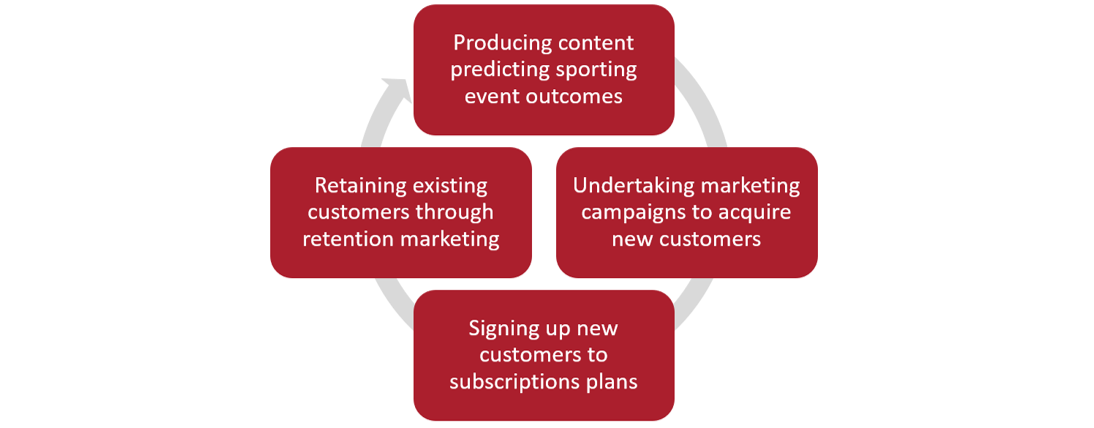
Understanding the business model also determines the key metrics the model must generate beyond the standard outputs of the three financial statements.
With a subscription business, for example, these metrics include total subscribers, monthly recurring revenue, customer acquisition costs, lifetime customer value, churn rates and so on. The key point is that the model and the metrics it generates must be directly relevant to the business model.
If the business was, say, an eCommerce platform or a two-sided marketplace, a consulting firm, a peer-to-peer lender or any other form of business, the structure and logic of its financial model would need to accommodate the specifics of that business model.
As a side-note, it is often useful when building a start-up financial model from scratch to identify listed companies with similar business models and to closely read their prospectuses, annual reports, investor presentations and so on.
These offer valuable reference points for how to structure your own financial model and it also provides insight into the key metrics that managers and investors track with such businesses. For example, Facebook’s Q3 FY18 presentation identifies key metrics for the company including:
- Daily Active Users;
- Monthly Active Users;
- Revenue;
- Average Revenue Per User; and
- Expenses as a Percentage of Revenue.

If you were building a financial model for a social network, this material offers valuable insight into the key metrics that your model would need to focus on.
It is also important to note that to a start-up investor, a key consideration is the rate of cash burn and the amount of so-called runway that remains available to the company at any point in time. These are company survival metrics and any start-up model needs to clearly highlight them.

Step Two: Clearly Identify Your Start-Up Business’ Sales Funnel
Once you understand the underlying value creation dynamics of the business, the next step for building a start-up’s financial model is to unpack the business’ sales and marketing funnel. This refers to the process and activities through which the company seeks to acquire customers.
We think that a helpful analogy here is the steam train. The engine is the business model – how the train generates power. The fireman is the marketing funnel – the more coal and the higher the quality of that coal that the fireman can shovel into the furnace, the harder the engine can run.
Typically, a sales funnel will operate through a series of stages where awareness of the company’s product or service is built at the top and the resulting prospects are walked through a process designed to convert them into customers.

In the real-world, sales funnels are generally complex and multifaceted. Most businesses will rely on a variety of marketing channels and strategies to generate new customers with each element having its own unique performance metrics.
For most start-ups, we recommend that a start-up financial model should have no more than two marketing funnels – a primary and a secondary channel. In addition, we recommend that each sales funnel should have no more than two stages through which prospects proceed.
Let’s see how those two sales funnels might roll out:

What we can see is that the primary funnel, paid social media, is forecast to generate 168 customers per month based on assumed click-through and conversion rates. The second channel, organic search, will generate 48 customers via search engine optimisation, content marketing and so on.
These forecast sales volumes need to then be tied to assumed selling prices to derive revenue figures.
Note that some start-ups, like Need a Barista, will have ready access to these inputs because they have a track record to draw on. Where that is not the case, customer acquisition experiments will need to be conducted or some other basis to secure benchmark data will need to be found.
This overall approach is termed a “bottom-up” approach where revenue is built from the ground up. The alternative is a “top-down” approach where the size of the market is identified and, say, a penetration rate of X% a year is assumed.
We strongly believe that a bottom-up approach is a superior one for a start-up company because it provides more granular information that directly shows how the company plans to build market share and what sorts of marketing performance metrics it will need to achieve to do so.
So, what will investors look at with a sceptical eye when assessing marketing funnel metrics?
- Revenue that comes online too early in a start-up’s life;
- Revenue growth that ramps up too quickly;
- Extremely high revenue growth rates that persist for too long;
- Revenue growth driven by unrealistically low customer acquisition costs.
Step Three – Build Up The Cost Structure Of The Business
Having modelled the sales funnel and resulting revenue figures, the next step is to start building out the start-up’s expenses. Note that some of this data will have already been generated by the assumptions around marketing funnel expenditures.
For a typical start-up, the most significant category of expenses will typically be staffing. An effective approach for modelling staffing expenses is to specifically break down the timing and cost of each individual employees as shown below.
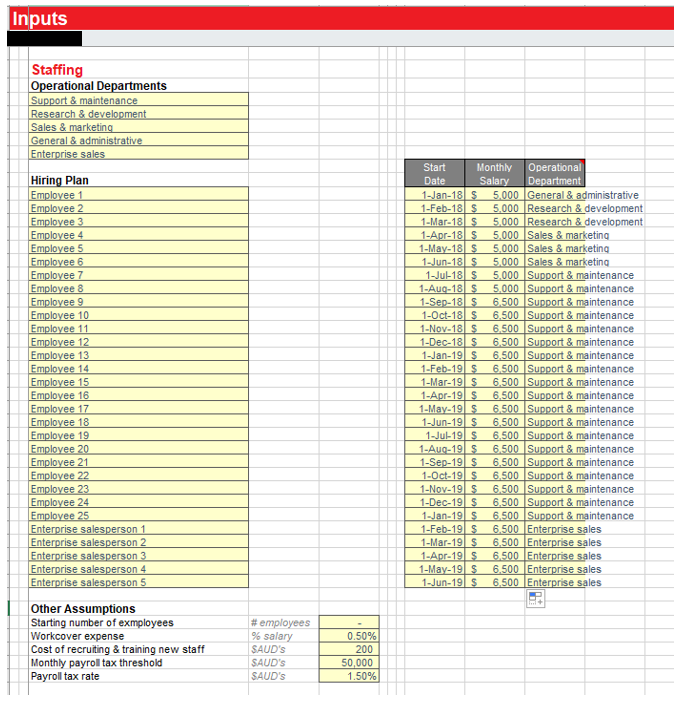
This approach can also incorporate discretionary aspects such as bonuses, salary increases and so on.
Beyond staffing, the full range of other operating expenses need to be incorporated into expense calculations. This will require careful analysis of the business’ activities and operating environment, and it is where business judgement and considerations of materiality are key.
For example, the hosting costs of a cloud-based SaaS platform are likely to be far more significant to a start-up than the number of reams of copying paper expected to be used in the next six months. So, when it comes to modelling expenses, pick your battles and focus on the items that matter.
At a higher level, there are many ways in which costs can be categorised within a financial model. For example:
- By operational department or function;
- Operating versus capital;
- Direct versus indirect;
- Fixed versus variable.
When classifying expenses, thought needs to be given to what classifications will offer provide users with the most pertinent information.
Finally, the key question an investor is going to ask when assessing a start-up’s expense forecasts is whether they are realistic. Too often we see companies projecting exponential growth on the back of very low expenses, which often looks suspiciously naïve at best. See below:

Again, it is worth looking at listed peers to get a feel for the types of margins at play in your industry. If your margins are orders of magnitude more impressive, you better be able to justify them or consider revising your forecasts.
Step Four – Build Scenarios
It doesn’t matter how confident you may be in your forecasts, it is important to recognise that the unexpected happens. Particularly with start-up companies revenue takes longer to come online, expenses ramp up more quickly than expected and so on.
Therefore, any robust start-up financial model should have built-in functionality that allows users to toggle between different scenarios to assess the impact of different assumptions – ranging from the aggressively optimistic through to the downright pessimistic.
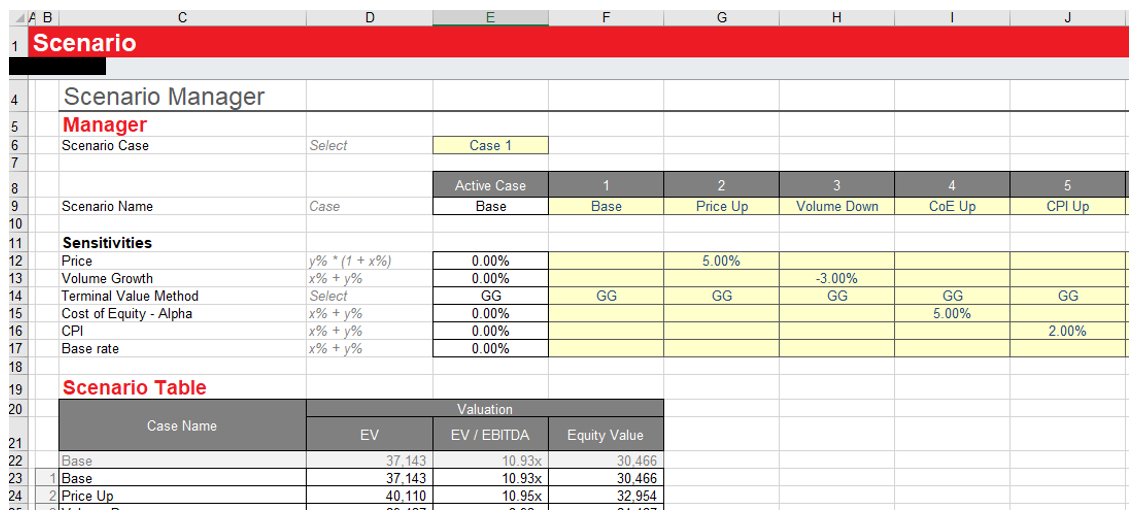
Essential Elements Of A High Quality Start-Up Financial Model
The preceding discussion focused on how to set about building a robust financial model for a start-up that is based on realistic operating assumptions. The emphasis so far has not been on Excel. What follows are several “best practice” principles of spreadsheet design.
a. Separating Inputs, Calculations & Outputs
An easy-to-follow start-up financial model collects all of a model’s assumptions in the one place so that a reviewer can easily identify and understand them. Below is an example from a model that uses a dedicated inputs sheet with clear (yellowed) input cells.
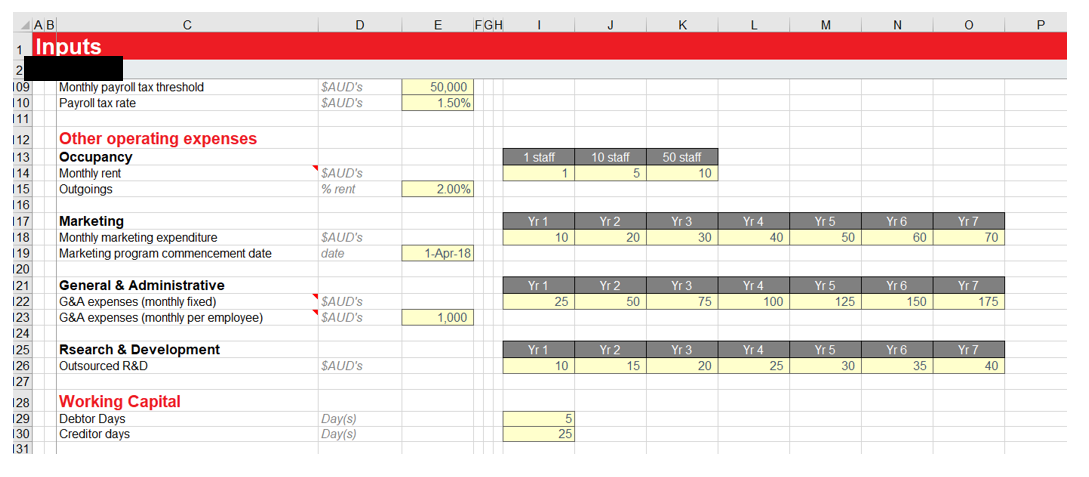
This is a far superior approach to embedding assumptions directly in formulas where their existence, impact and origin may be obscured. Embedding assumptions in this way also reduces the flexibility of the financial model.
Further, an understandable model separates inputs from calculations and outputs. That way someone can clearly see the assumptions underlying the model, how those assumptions are used in the model and what the results of those assumptions are.

b. Keep Formulas Simple
For whatever reason, the moment some people jump behind the keyboard to work in Excel, they immediately want to show people how clever they are. This tends to manifest itself in the form of long, incomprehensible formulas that would take a reviewer a whole afternoon to decipher.
Whether the above formula is that complex or not – and it probably isn’t to the person who wrote it – it does require significant effort on the part of someone coming to it cold. Our advice is to always aim to keep formulas short and to break them down over multiple rows if necessary.

c. Identify Units Of Measurement
It is helpful in a financial model to explicitly identify the relevant units of measurement that applies to each row of the model. This is particularly important on input and summary-type pages where different units are commonly used.
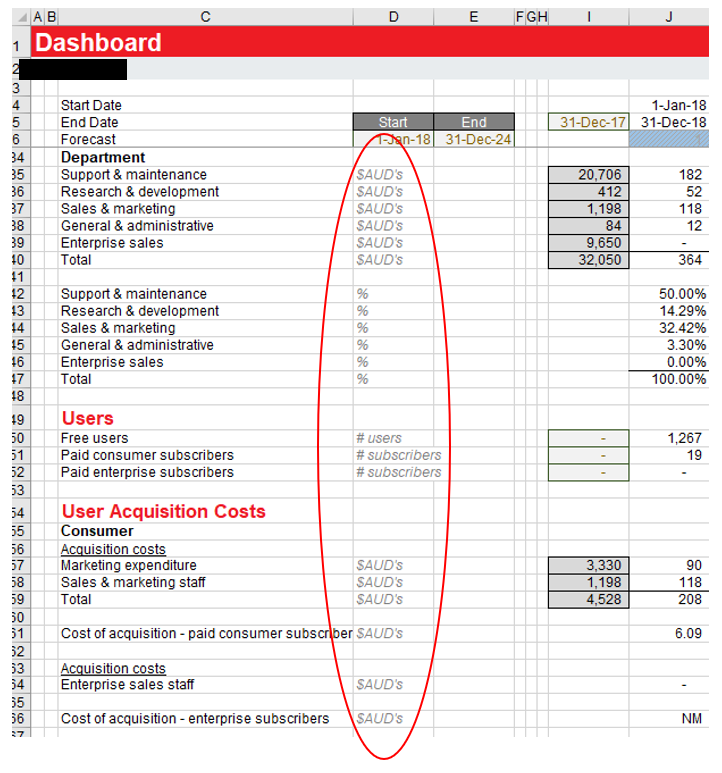
d. Use Consistent And Meaningful Formatting
Another way to enhance a model’s understandability is to use consistent formatting. Using different colours, shading, underlining and so on can do a lot to contribute to the ease with which a model can be quickly and easily understood. It can also make a model hard to follow when it is particularly idiosyncratic and inconsistent.
Consider employing a legend to explain what different formatting means within your model. This also forces you to remain disciplined in the use of formatting.

e. Use Comments
Often when you are building a start-up financial model, what is screamingly obvious to you may be far less obvious to someone looking at your model for the first time. That is why we encourage you to use comments throughout your model to highlight
Above is a brief overview of some of the considerations that need to go into building an effective start-up or early-stage company financial model. We find that going through the exercise of building such a model is invaluable for company founders. If you want to discuss how CFSG can assist you with your financial modelling needs, please don’t hesitate to contact us.